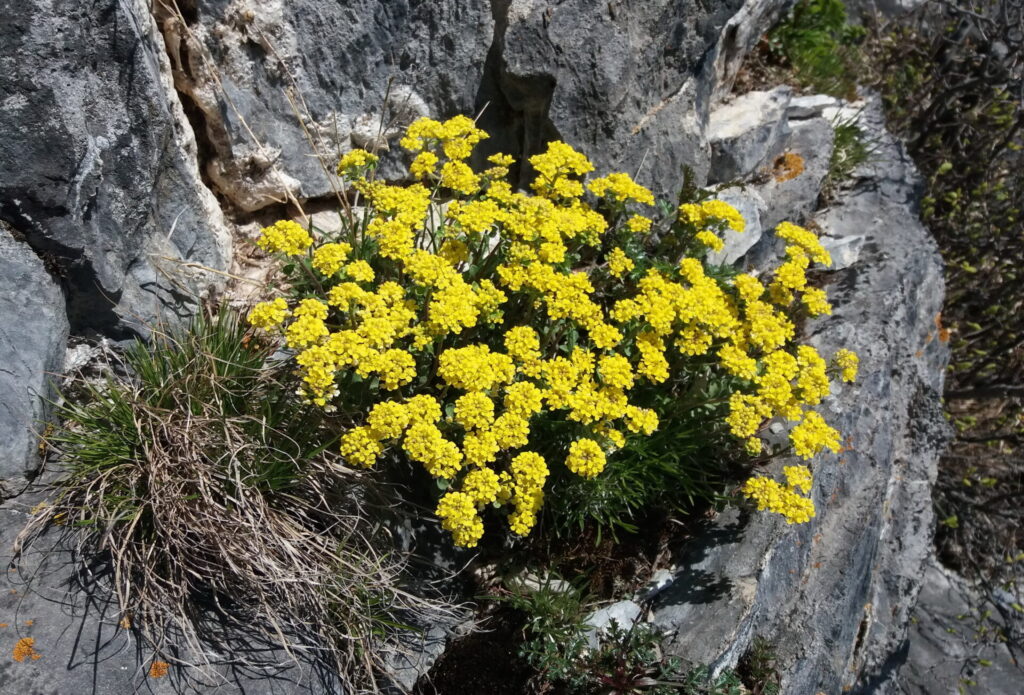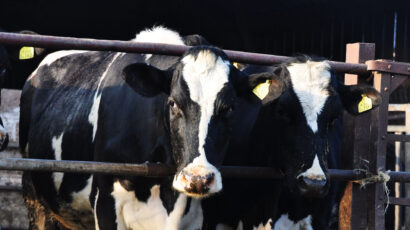The greenest way to mine metals for batteries could be with plants
By Matt Simon | March 26, 2024
 Many species of Alyssum are nickel hyperaccumulators, which can tolerate and absorb high levels of metals. (Photo: Nina Filippova/Wikipedia)
Many species of Alyssum are nickel hyperaccumulators, which can tolerate and absorb high levels of metals. (Photo: Nina Filippova/Wikipedia)
Editor’s note: This story was originally published by Wired. It appears here as part of the Climate Desk collaboration.
Gouging a mine into the Earth is so 1924. In 2024, scientists are figuring out how to mine with plants, known as phytomining. Of the 350,000 known plant species, just 750 are “hyperaccumulators” that readily absorb sky-high amounts of metals and incorporate them into their tissues. Grow a bunch of the European plant Alyssum bertolonii or the tropical Phyllanthus rufuschaneyi and burn the biomass, and you end up with ash that’s loaded with nickel.
“In soil that contains roughly 5 percent nickel—that is pretty contaminated—you’re going to get an ash that’s about 25 to 50 percent nickel after you burn it down,” says Dave McNear, a rhizosphere biogeochemist at the University of Kentucky. “In comparison, where you mine it from the ground, from rock, that has about .02 percent nickel. So you are several orders of magnitude greater in enrichment, and it has far less impurities.”
Now the US government’s Advanced Research Projects Agency-Energy, aka ARPA-E, wants in on the action. Today it’s announcing up to $10 million in funding to explore ways to use plants for extracting nickel from American soils. They’re calling the exploratory topic “Plant HYperaccumulators TO MIne Nickel-Enriched Soils,” or PHYTOMINES, encouraging partnerships between scientists, farmers, and the battery and mining industries. The idea is to find the right kind of hyperaccumulator—ideally a native North American species—that can grow quickly and suck up a lot of nickel. That could bolster the domestic supply of nickel, which the feds consider a “critical material”—an essential ingredient in the batteries that are themselves essential to the renewable revolution.
“By exploring phytomining to extract nickel as the first target critical material, ARPA-E aims to achieve a cost-competitive and low-carbon-footprint extraction approach needed to support the energy transition,” said ARPA-E director Evelyn N. Wang in a statement provided to WIRED.
Getting plants to phytomine nickel from soils could supplement conventional mining of the metal and reduce imports, the agency says. Plus, as plants grow, they suck carbon dioxide out of the atmosphere. That plant carbon returns to the atmosphere when the plants are burned, but the net emissions of the technique are relatively low. In comparison, a traditional mine’s heavy machinery both spews greenhouse gases and chews up ecosystems.
This isn’t an especially new concept—scientists have explored phytomining for years. “It is an area that has historically been on the edges of possibility,” says Patrick Brown, a plant scientist at the University of California, Davis. “From time to time people have written about this as the Next Great Thing, but it’s never come to pass because there’s never been adequate investment into it.”
Excessive amounts of nickel in soil prevents typical plants from growing. Hyperaccumulators not only are able to tolerate the metal, but are protected by it, as their metal-rich leaves fend off herbivores. It’s metal armor, essentially. (Hyperaccumulators use protective proteins, for instance, to bind to the metal. Evolving to process nickel would have given hyperaccumulators a competitive advantage, allowing them to colonize soils that other plants couldn’t.) Around three-quarters of the 750 hyperaccumulators specifically accumulate nickel. ARPA-E says that plants in the sunflower and mustard families could be especially suitable for use in the US.
“Just like we do research with corn, wheat, soybean, getting these plants to be more efficient in taking up nutrients—nitrogen, phosphorus, potassium—well, there needs to be this research that goes into understanding the mechanisms of metal hyperaccumulation,” says McNear. “And then enhancing that, whether it be through gene editing or whatever.”
ARPA-E is eying a specific kind of dirt to try these plants in, known as ultramafic soil, which is high in iron, cobalt, chromium, and nickel. It’s common where there’s been volcanic activity, for instance in northern California and southern Oregon, but is present across the US, from Wyoming to Pennsylvania, on down into the South. The concentration of nickel in ultramafic soil is probably too low to open a proper mine, but too high to grow crops and other vegetation.
With this new funding, scientists might accentuate or breed existing plant species, tweaking the way they hyperaccumulate nickel. Ideally, they’d land on a plant that grows quickly, so you’d end up with a lot of nickel-rich biomass to reduce to metal-laden ash. “The problem has historically been that they’re not often very productive plants,” says Brown. “And the challenge is you have to have high concentrations of nickel and high biomass to achieve a meaningful, economically viable outcome.”
Provided scientists can land on the right hyperaccumulating plant for the US, theoretically it could provide more nickel for more batteries. It’s not just the growing fleets of electric vehicles that are demanding more batteries: The grid, too, will need big ones to store energy generated by renewables like wind and solar power. When the sun isn’t shining and wind isn’t blowing, grid operators will need to tap into batteries to meet demand. Utilities are also experimenting with ways to tap into EVs sitting in garages as a distributed network of battery backup power.
Of course, ARPA-E’s hyperaccumulating plants would have to play nicely with ecosystems—you certainly wouldn’t want them to go invasive and outcompete native species. But the idea is that over time, phytomining would actually improve soils, extracting enough nickel for other non-hyperaccumulating plants to eventually grow. Hyperaccumulators can even clean up soils contaminated through traditional nickel mining, like around smelting facilities, as McNear has experimented with. “What goes out the smokestack gets deposited around that facility,” he says. “Farmers couldn’t use that land anymore, because it was too heavily enriched in nickel, but they could grow a crop of nickel and sell it back to the smelter—a win-win really.”
At the moment, ARPA-E is focusing on phytomining nickel, but it says it could in theory also explore ways for plants to extract cobalt, copper, or lithium. That’s green technology, in the truest sense of the word.

Together, we make the world safer.
The Bulletin elevates expert voices above the noise. But as an independent nonprofit organization, our operations depend on the support of readers like you. Help us continue to deliver quality journalism that holds leaders accountable. Your support of our work at any level is important. In return, we promise our coverage will be understandable, influential, vigilant, solution-oriented, and fair-minded. Together we can make a difference.
Keywords: APRA-E, battery power, climate crisis, metals, mining
Topics: Climate Change
















If we use use these types of plant to absorb heavy metals for use in batteries, that is better than massive mining operations. However, what damage and impact is this going to have on native insects and bees that use pollen.